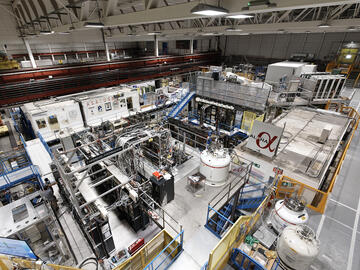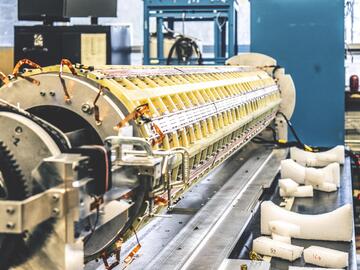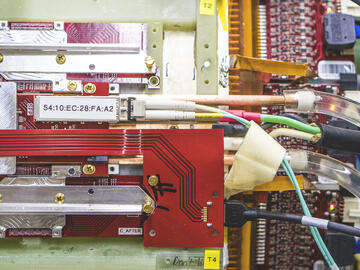Sept. 27, 2023
Does antimatter fall up or down? UCalgary physicists observe 1st gravitational free-fall of antimatter

The physics behind antimatter is one of the world’s greatest mysteries. Looking as far back as The Big Bang, physics has predicted that when we create matter, we also create antimatter. The world around us is made of matter, but physicists have yet to find an explanation for the absence of antimatter.
Now, physicists have just answered a long-standing question that will lead to a deeper understanding of this mystery: does antimatter fall up or down?
The Antihydrogen Laser Physics Apparatus (ALPHA) collaboration at CERN, the European Organization for Nuclear Research, completed the first direct measurement of gravity’s effect on the motion of antimatter using its new ALPHA-g apparatus. As expected by much of the scientific community, antimatter falls downward. This is a tremendous scientific and technical achievement that marks a leap forward in the world of antimatter research. The collaboration’s findings are published in Nature today.
UCalgary’s involvement with ALPHA is led by Dr. Robert Thompson, PhD, and Dr. Timothy Friesen, PhD, from the Department of Physics and Astronomy. Physicists used antihydrogen, the simplest antimatter atom, to perform the experiment.

Robert Thompson, far left, and Timothy Friesen, far right, with summer student Abby Swadling, centre left, and graduate student Pooja Woosaree in the machine shop at the University of Calgary.
University of Calgary
“Right now, we don’t have an explanation about where all the antimatter in the universe is,” says Thompson, professor of physics and principal investigator of the ALPHA-g Canada Foundation for Innovation (CFI) project. “To find a solution for this conundrum, what we do is test the elements of physics of antimatter to see if we can find an inconsistency. In this case, we tested to see if the gravitational characteristics of antihydrogen mirror those of hydrogen, which is significant because it’s never been done before.”
The publication is the result of 20 years of work by a collaborative group of physicists from institutions around the world, including UCalgary. Thompson’s CFI project, valued at over $17 million including provincial and international match funding, was critical to the project, providing the investment to build the ALPHA-g apparatus required to conduct the experiment.
How do you measure antimatter?
ALPHA has previously carried out precision measurements of the charge and colour spectrum of antihydrogen, which to date remain all consistent with current physical models. The antimatter gravity measurement was carried out in the new ALPHA-g apparatus, now in operation at CERN. After creating antimatter, trapping the neutral antihydrogen atoms in a magnetic bottle, making the environment as cold as possible, physicists then released the antihydrogen within the vertical apparatus to witness and measure its gravitational behaviour.
The ALPHA collaboration recognizes this milestone as the first step in taking more precise measurements of the gravitational properties of antimatter to determine whether antimatter falls in the exact same way as matter. This could help physicists understand the lack of antimatter observed in the universe.
“We know there’s a problem somewhere in quantum mechanics and gravity,” says Friesen, assistant professor in the Department of Physics and Astronomy, and major contributor to the Nature paper. “We just don’t know what it is. There has been a lot of speculation on what happens if you drop antimatter, though it’s never been tested before now because it’s so hard to produce and gravity is very weak.”
Custom-made components crafted in UCalgary workshop
An experiment like this requires custom-made machinery, built with components that must be precisely crafted down to a fraction of a millimetre. Luckily for Thompson and Friesen, they have an incredible team of craftspeople on campus in the Science Workshop, led by Todd Willis.
“We worked with Todd and the team in the Science Workshop to design and build core components of the antimatter traps,” says Friesen. “They used their expert skills to make the components to our exact specifications and within the tight tolerances we needed, and even out-performed a Swiss precision machining company we had previously worked with.”
Willis and team crafted the parts, and working in collaboration with other ALPHA-Canada-affiliated workshops, assembled the parts and shipped them to CERN, where they were installed in ALPHA-g.
History-making hands-on learning for students and trainees
Since the experiment began, UCalgary has had a number of scholars involved, all who are named in the Nature publication.
“This project has been an incredible teaching and learning opportunity for our students and trainees,” says Thompson. “We couldn’t have done this without their knowledge, creativity, and determination. Not a lot of students finish a post-secondary degree with a history-making publication on their CV — we were thrilled to be able to give them that opportunity.”
Along with Friesen and Thompson, additional UCalgary authors from the Faculty of Science are Dr. Chukman So, PhD (former Eyes High postdoc and adjunct professor), Dr. Alberto Jesus Uribe Jimenez, PhD (postdoctoral scholar), Dr. Andrew Evans, PhD (former Eyes High doctoral student and alum), and Adam Powell and Pooja Woosaree (doctoral students). Former undergraduate students Abbygale Swadling and Benjamin Appleyard are also acknowledged in the paper as part of the project team.
International collaboration critical to project’s success
ALPHA-g was designed, constructed and commissioned through an international partnership of research institutions including, on the Canadian side, the University of Calgary, Simon Fraser University, TRIUMF, the University of British Columbia, and York University, as well as post-secondary institutions and research institutes in Europe, the United Kingdom and the United States.
Building the ALPHA-g apparatus was only the first step. Observing the free-fall of antimatter involved the entire ALPHA collaboration, including researchers from the above institutions and countries, as well as from the British Columbia Institute of Technology and researchers from Israel and Brazil.
"This milestone is a culmination of nearly 20 years of dedication and teamwork. The contributions of the members of ALPHA-Canada were critical to our success,” says Dr. Makoto C. Fujiwara, senior scientist from TRIUMF and ALPHA-Canada spokesperson.
"ALPHA-Canada is a pan-Canadian collaboration made up of a diverse group of students, postdoctoral scholars, academics and staff members, each who played a vital role in this project."
CERN
ALPHA is an international collaboration based at CERN, which studies antihydrogen atoms, the antimatter counterpart of the simplest atom, hydrogen. By comparisons of hydrogen and antihydrogen, the experiment hopes to understand fundamental symmetries between matter and antimatter.
ALPHA-Canada is a significant group in ALPHA, constituting more than one third of the international collaboration. ALPHA-Canada consists of approximately 20 researchers and students from six Canadian institutions: The University of Calgary, Simon Fraser University, TRIUMF, the University of British Columbia, British Columbia Institute of Technology, and York University. ALPHA-Canada’s research is supported in part by the Natural Sciences and Engineering Research Council of Canada.
This is the first major result from the ALPHA-g apparatus, which was funded through the Canada Foundation for Innovation. Major contributing partners include the Government of Alberta, the British Columbia Knowledge Development Fund, the Ontario Research Fund, Carlsberg Foundation (Denmark), and U.K. Government funding through the University of Manchester and Swansea University.














